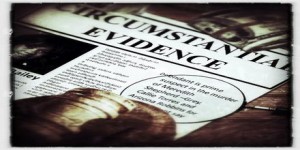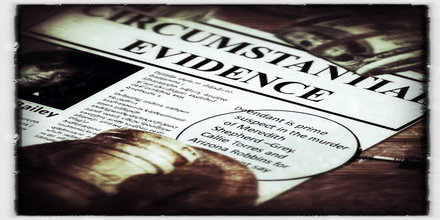In this blog post, Nalini Chandrakar, student, Hidayatullah National Law University, and Vineet Kumar, Student, National Law University of Odisha, write about whether circumstantial evidence can be taken as the sole basis of conviction or not—proving the statement with few landmark cases.
Introduction
“Men may tell a lie, women may a tell lie, but circumstances do not tell a lie.”
When someone commits a crime he makes sure that there would be no evidence left that can prove him guilty making the case an open and shut case. But then, even if you are playing smart like purchasing witnesses, removal of weapon used to commit the crime, etc., one cannot change the circumstance revolving around the whole case, and that becomes the strongest evidence to prove the guilt of the accused.  One should be aware of the fact that whenever a case is presented before the court, the evidence turns out to be the eyes and ears of justice. The task to differentiate between the two—victim and the culprit is never a cake walk for the judge as he was not present when the crime took place. Hence, evidence plays a vital role in determining whether the accused is guilty or not.
One should be aware of the fact that whenever a case is presented before the court, the evidence turns out to be the eyes and ears of justice. The task to differentiate between the two—victim and the culprit is never a cake walk for the judge as he was not present when the crime took place. Hence, evidence plays a vital role in determining whether the accused is guilty or not.
Analysis of the Term Evidence
Evidence is that piece of documents and information which is presented before the judge to reach a conclusion. According to Section 3 of Indian Evidence Act, 1872[1] —
- All the statements which the Court permits or requires to be made before it by witnesses, about matters of fact under inquiry; such statements are called Oral evidence;
- All the documents including electronic records produced for the inspection of the Court; such documents are called documentary evidence;
Further, there are various forms of evidence such as[2] Oral evidence, Documentary evidence, Primary evidence, Secondary evidence, Real Evidence, Hearsay evidence, Non-Judicial evidence, Direct evidence and Circumstantial evidence.
What do you mean by Circumstantial Evidence?
 Peter Murphy defines it as “evidence from which the desired conclusion may be drawn but which requires the tribunal of fact not only to accept the evidence presented but also draw an inference from it.”[3] Circumstantial Evidence is also known as indirect evidence. There’s always a myth lying behind circumstantial evidence that it’s evident enough to prove someone guilty of his act as the evidence is based upon the circumstances rather than direct evidence which has the upper hand in this. However, when there is an absence of direct evidence the case solely depends on the circumstantial evidence. Now, it’s the work of the jury to critically analyze the validity of circumstantial evidence as it’s a string connecting the facts to recreate the crime scene in a court room. Circumstantial Evidence is used both in civil and criminal matters but mostly in criminal matters.
Peter Murphy defines it as “evidence from which the desired conclusion may be drawn but which requires the tribunal of fact not only to accept the evidence presented but also draw an inference from it.”[3] Circumstantial Evidence is also known as indirect evidence. There’s always a myth lying behind circumstantial evidence that it’s evident enough to prove someone guilty of his act as the evidence is based upon the circumstances rather than direct evidence which has the upper hand in this. However, when there is an absence of direct evidence the case solely depends on the circumstantial evidence. Now, it’s the work of the jury to critically analyze the validity of circumstantial evidence as it’s a string connecting the facts to recreate the crime scene in a court room. Circumstantial Evidence is used both in civil and criminal matters but mostly in criminal matters.
For example, A, B and C are three friends living in the same apartment. One day, A hears some noise coming from B’s room when he recognizes that B is not alone in the room C is also there, and some argument is going on between them. After a few minutes, A hears the voice of B shouting for help, as soon as he runs towards the door of B’s room, C comes out of the room with a knife in his hand covered with blood and B lying dead on the floor.
Here A has not seen C killing B in front of his eyes but has found C holding the murder weapon and coming out of the room. Therefore, the testimony of A becomes circumstantial evidence from which it can be inferred that C murdered B. The panel of judges must determine whether A’s statement is credible or not.
On the second aspect – If A has seen C killing B right in front of his eyes then his testimony would have become direct evidence for the jury to penalize the criminal.
Essentials of Circumstantial Evidence
Evidence plays a vital role in delivering justice to the innocent. However, one should take care of any evidence which is going to be produced before the court. As it must fulfill the essential elements of being admissible in court. A case can be solely adjudged by circumstantial evidence if the following essentials are fulfilled[4] –
- The circumstance from which the guilt is established should be proven;
- That each one the facts should be according to the hypothesis of the guilt of the accused;
- That the circumstances should be conclusive in nature and tendency;
- That the circumstances ought to, to an ethical certainty, truly exclude each hypothesis except the one projected to be evidenced.
- The evidence should prove the guilt of the culprit beyond a reasonable doubt.
Similarly in the case of Bodh Raj vs. State of Jammu and Kashmir[5] –
- The circumstances from where conclusion of guilt is to be drawn ought to be established. The circumstances involved ‘must’ or ‘should’ and not ‘may be’ established.
- The facts, therefore, established ought to be as per the hypothesis of the guilt of the accused.
- Circumstances ought to be conclusive in nature and tendency.
- They ought to exclude each attainable hypothesis except the one to be tested.
- There should be a complete sequence of proof so as to not leave any affordable ground for the conclusion in line with the innocence of the defendant and should show that the act must have been done by the defendant.
Application of Circumstantial Evidence the case of Jessica Lal
The Jessica Lal murder case is one of the most cited, debated and controversial cases where the Apex Court’s decision was based on the circumstantial evidence as the witnesses had turned hostile. Initially, the trial court had acquitted the accused on the ground of hostile witnesses and lack of strong evidence. Delhi High Court reversed the judgment and held Manu Sharma (the accused) guilty of murdering Jessica Lal, who was a bartender at a restaurant in Qutub Colonnade in the capital city, and was shot by Sidhartha Vashisht alias Manu Sharma, the son of a senior Congress Party politician and former Union minister, when she refused to give him liquor as the bar was closed.[6]
“After several days in hiding, Sharma surrendered to the authorities in Chandigarh. In an interview with the police that was subsequently broadcasted on national television, Sharma confessed to the murder. This confession was later retracted, and a plea of non-guilty was petitioned at the trial. During the trial, the three critical eye witnesses recanted earlier statements made to the police, and twenty-nine witnesses of lesser importance did the same. One of the eye witnesses, Shyan Munshi, changed his testimony so much so that his revised statement was used as exculpatory evidence by the defense”.[7] This way, a case that could have been easy to prove started looking like a fake one at the very ground and acquired a dramatic phase. The trail court delivered its verdict on the grounds of such evidences produced and did not go beyond them, or deep to know the role of the accused and acquitted Sharma and eight other co-defendants of all charges in February 2006, though it accepted Manu Sharma’s presence on that night at the restaurant along with the other accused as having been proved. The trial judge commented after the outcome that:
“The court has acquitted them because the Delhi police failed to sustain the grounds on which they had built up their case. The police failed to recover the weapon which was used to fire at Jessica Lal as well as prove their theory that the two cartridges, emptied shells of which were recovered from the spot, were fired from one weapon”[8].
The case acquired such a high-profile character that the then President Dr. Abdul Kalam received a petition of 200, 000 names collected by journalists at NDTV, appealing against the judgment.
Delhi High Court, deciding on the appeal from this case investigated into the circumstantial evidence and found that the cartridges found belonged to the accused and stated that the lower court had been lax in not considering the testimony of witnesses such as Bina Ramani and Deepak Bhojwani, stating regarding the treatment of the latter’s evidence that
“With very great respect to the learned judge [Bhayana], we point out that this manner of testing the credibility of the witness is hardly a rule of appreciation of evidence. … Obviously, this reflects a total lack of application of mind and suggests a hasty approach towards securing a particular end, namely the acquittal”.[9]
The accused was sentenced to life imprisonment together with a fine of Rs.50,000 to be paid to the family of the victim. The Apex Court upheld the judgment of the Delhi High Court and the Bench comprising Justices P. Sathasivam, and B. Swatenter Kumar held that the presence of the accused at the scene of the crime had been proved through the ocular testimonies of several witnesses. The circumstantial evidence connecting the vehicles and cartridges used at the site of the crime to Manu Sharma as well as his conduct after the incident (he first absconded but surrendered later) proved his guilt beyond reasonable doubt.[10] Manu Sharma’s counsel, Ram Jethmalani, argued before the Apex Court that non-disclosure of one of the ballistic reports to Manu Sharma by the prosecution had hindered the ends of justice. The Bench, however, disagreed, saying that no prejudice has been caused to the accused’s right to fair trial because of this non-disclosure. The Supreme Court held that the High Court, as the appellate court, had all the necessary powers to re-evaluate the evidence presented before the trial court as well as the conclusions reached. Therefore, the High Court, in this case, had given cogent and adequate reasons reversing the order of acquittal.[11]
[divider]
Footnotes:
[1] Indian Evidence Act, Ratanlal & Dhirajlal, Lexis Nexis Butterworths Wadhwa, 21st Edition, Nagpur
[2] http://www.legalindia.com/different-kinds-of-evidences-witnesses-under-the-indian-evidence-act/
[3] S.R. Myeni, The Law of Evidence, (Hyderabad: Asia Law House 2007), 20
[4] State of UP vs. Ravindra Prakash Mittal, AIR 1992 SC 2045
[5] AIR 2002 SC 316
[6] 2001 III AD Delhi 829
[7] Public Outrage and Criminal Justice: Lessons from the Jessica Lal Case, Brendan O’Flaherty, Rajiv Sethi (Accessed at http://www.columbia.edu/~rs328/Jessica.pdf)
[8] All accused acquitted in Jessica Lal murder case, The Hindu, 22 February 2006
[9] “Key witness in Jessica case dubbed liar by HC,” Rediff. PTI. 19 December 2006
[10] Conviction confirmed in Jessica Lal case, Frontline (Vol. 27 – Issue 10) (May 8-21, 2010) (Accessed at http://www.frontline.in/static/html/fl2710/stories/20100521271013400.htm)
[11] Cri Appeal No. 179 of 2007










